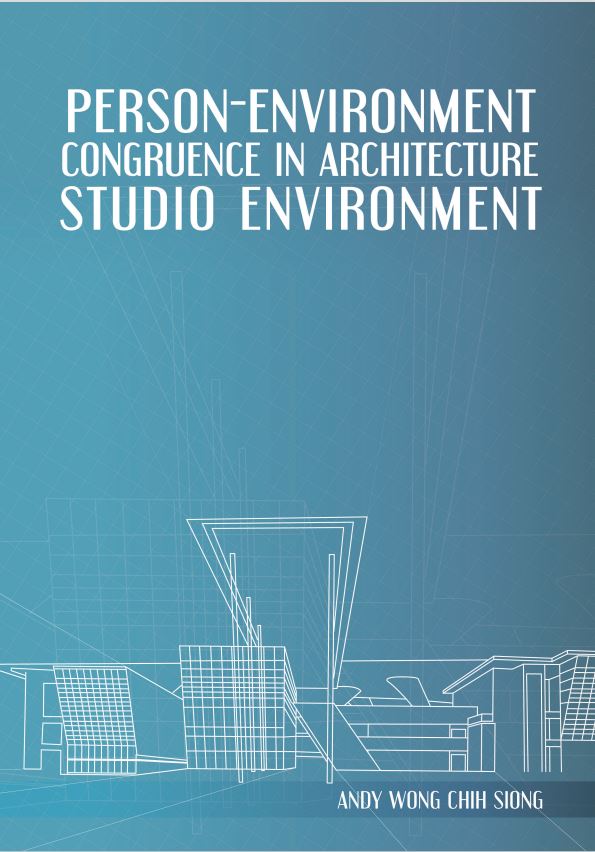
PERSON-ENVIRONMENT CONGRUENCE IN ARCHITECTURE STUDIO ENVIRONMENT
RM55.00
The studio is a central hub of architectural teaching and learning. This book investigates the relationship between architecture students and the studio environment in the notion of Person-Environment Congruence (PEC). PEC emphasizes the capability of the studio environment to fulfil architecture students’ needs. The focus is thus on the state of being congruent between students’ essential learning needs and the studio attributes around them. This book reveals sixteen key studio attributes from the perspective of architecture students falling under five categories. These categories comprise Physiological Facilities, Information and Communications Technology, Indoor Environment Quality, Territoriality, Furniture, and Reference. Furthermore, the
discussion also concentrates on motivational beneficial consequences and values that influence these studio attributes. This book showcases the importance of achieving Person-Environment Congruence in providing a sustainable and conducive studio environment aligned with architecture students’ needs.
Authors
Andy Wong Chih Siong
CONTENT
List of Tables
List of Figures
Abbreviations
Preface
Acknowledgement
CHAPTER 1: INTRODUCTION
STUDIO IN ARCHITECTURE EDUCATION
DESIGN CHALLENGES OF STUDIO
CHAPTER 2: PERSON-ENVIRONMENT CONGRUENCE IN STUDIO CONTEXT
PERSON-ENVIRONMENT RELATIONSHIP
PERSON-ENVIRONMENT RELATIONSHIP
ACHIEVING PERSON-ENVIRONMENT
CONGRUENCE (PEC)
MODEL OF STUDENT-STUDIO RELATIONSHIP
CHAPTER 3: MOTIVATIONAL VALUES AND BENEFICIAL CONCEQUENCES OF PERCEIVED STUDIO ATTRIBUTES
MOTIVATIONAL VALUES AND BENEFICIAL ATTRIBUTES
MOTIVATIONAL VALUES OF PERCEIVED STUDIO DOMINANT BENEFICIAL CONSEQUENCES
Attaining Positive Outcomes
Positive Outcomes Motivated by Achievement
Positive Outcomes Motivated by Security
Positive Outcomes Motivated by Conformity
Positive Outcomes Motivated by Conformity
Positive Outcomes Motivated by Power Value
Positive Outcomes Motivated by Hedonism
Increasing Efficiency
Efficiency Motivated by Achievement
Efficiency Motivated by Security
Efficiency Motivated by Self-Direction
Efficiency Motivated by Hedonism
Efficiency Not Directly Motivated by Conformity and Power
SUMMARY
CHAPTER 4: PERCEPTION OF STUDIO ATTRIBUTES
SIX DISTINCT CATEGORIES OF STUDIO ATTRIBUTES
Studio Attributes of Indoor Environmental Quality
Air Conditioning
Ventilation
Lighting
Studio Attributes of Information and Communications Technology
High-Speed WiFi
High-Spec Computer
Plotter
Power Socket
Studio Attribute of Territoriality
Private Workspace
Group Work Area
Studio Attributes of Furniture
Table and Chair
Lockable Cabinet
Studio Attributes of Physiological Facilities
Pantry
Leisure Area
Sleeping Area
Pot Plant
Studio Attributes of Reference
Mini Library
Summary
CHAPTER 5: STUDENTS’ PRIORITISATION OF STUDIO ATTRIBUTES
DETERMINING THE IMPORTANCE OF STUDIO
ATTRIBUTES
RANKING OF STUDIO ATTRIBUTES
RELATIVE IMPORTANCE OF STUDIO ATTRIBUTES
RANKING OF STUDIO ATTRIBUTE CATEGORIES
RELATIVE IMPORTANCE OF STUDIO ATTRIBUTE CATEGORIES
PRIORITISATION OF STUDIO ATTRIBUTES
Studio Attributes of Indoor Environmental Quality
Studio Attributes of Information and
Communications Technology
Studio Attributes of Territoriality
Studio Attributes of Furniture
Studio Attributes of Physiological Facilities
Studio Attributes of Reference
SUMMARY
CHAPTER 6: CONDUCIVE STUDIO STUDENTS’ PERCEPTIONS OF STUDIO ATTRIBUTES
SIXTEEN STUDIO ATTRIBUTES
MOTIVATIONAL VALUES AND BENEFICIAL CONSEQUENCES
PRIORITISING THE STUDIO ATTRIBUTES
DESIGNING CONDUCIVE STUDIO
CONCLUSION
REFERENCES
INDEX
VI
VII
IX
X
XII
1
5
9
10
10
11
15
18
19
19
21
21
22
23
24
25
26
27
28
28
28
29
30
31
32
34
35
36
38
40
41
42
43
44
46
48
49
51
52
53
55
55
56
57
58
61
62
63
64
67
69
70
71
72
72
73
74
75
75
76
77
77
78
78
79
81
82
88
Purchase Book
To purchase this book please contact click link .
Centre Of Publication
University of Technology Sarawak
No 1 Jalan Universiti
96000 Sibu Sarawak
T: (+6) 084 367300
F: (+6) 084 367301
© University of Technology Sarawak. All Right Reserved.
